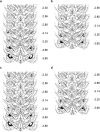Double dissociation of the requirement for GluN2B- and GluN2A-containing NMDA receptors in the destabilization and restabilization of a reconsolidating memory
- PMID: 23325248
- PMCID: PMC4241020
- DOI: 10.1523/JNEUROSCI.3273-12.2013
Double dissociation of the requirement for GluN2B- and GluN2A-containing NMDA receptors in the destabilization and restabilization of a reconsolidating memory
Abstract
Signaling at NMDA receptors (NMDARs) is known to be important for memory reconsolidation, but while most studies show that NMDAR antagonists prevent memory restabilization and produce amnesia, others have shown that GluN2B-selective NMDAR antagonists prevent memory destabilization, protecting the memory. These apparently paradoxical, conflicting data provide an opportunity to define more precisely the requirement for different NMDAR subtypes in the mechanisms underlying memory reconsolidation and to further understand the contribution of glutamatergic signaling to this process. Here, using rats with fully consolidated pavlovian auditory fear memories, we demonstrate a double dissociation in the requirement for GluN2B-containing and GluN2A-containing NMDARs within the basolateral amygdala in the memory destabilization and restabilization processes, respectively. We further show a double dissociation in the mechanisms underlying memory retrieval and memory destabilization, since AMPAR antagonism prevented memory retrieval while still allowing the destabilization process to occur. These data demonstrate that glutamatergic signaling mechanisms within the basolateral amygdala differentially and dissociably mediate the retrieval, destabilization, and restabilization of previously consolidated fear memories.
Figures






Similar articles
-
Increasing the GluN2A/GluN2B Ratio in Neurons of the Mouse Basal and Lateral Amygdala Inhibits the Modification of an Existing Fear Memory Trace.J Neurosci. 2016 Sep 7;36(36):9490-504. doi: 10.1523/JNEUROSCI.1743-16.2016. J Neurosci. 2016. PMID: 27605622 Free PMC article.
-
NMDA GluN2A and GluN2B receptors play separate roles in the induction of LTP and LTD in the amygdala and in the acquisition and extinction of conditioned fear.Neuropharmacology. 2012 Feb;62(2):797-806. doi: 10.1016/j.neuropharm.2011.09.001. Epub 2011 Sep 10. Neuropharmacology. 2012. PMID: 21925518
-
Thalamic nucleus reuniens regulates fear memory destabilization upon retrieval.Neurobiol Learn Mem. 2020 Nov;175:107313. doi: 10.1016/j.nlm.2020.107313. Epub 2020 Sep 19. Neurobiol Learn Mem. 2020. PMID: 32956808
-
Molecular mechanisms for the destabilization and restabilization of reactivated spatial memory in the Morris water maze.Mol Brain. 2011 Feb 11;4:9. doi: 10.1186/1756-6606-4-9. Mol Brain. 2011. PMID: 21314917 Free PMC article.
-
NMDA receptor antagonism in the basolateral but not central amygdala blocks the extinction of Pavlovian fear conditioning in rats.Eur J Neurosci. 2010 May;31(9):1664-70. doi: 10.1111/j.1460-9568.2010.07223.x. Eur J Neurosci. 2010. PMID: 20525079 Free PMC article.
Cited by
-
Memory reconsolidation in aversive and appetitive settings.Front Behav Neurosci. 2013 Sep 9;7:118. doi: 10.3389/fnbeh.2013.00118. Front Behav Neurosci. 2013. PMID: 24058336 Free PMC article. Review.
-
Subanesthetic Dose Ketamine in Posttraumatic Stress Disorder: A Role for Reconsolidation During Trauma-Focused Psychotherapy?Curr Top Behav Neurosci. 2018;38:137-162. doi: 10.1007/7854_2017_34. Curr Top Behav Neurosci. 2018. PMID: 29637527
-
Dual-step pharmacological intervention for traumatic-like memories: implications from D-cycloserine and cannabidiol or clonidine in male and female rats.Psychopharmacology (Berl). 2024 Sep;241(9):1827-1840. doi: 10.1007/s00213-024-06596-8. Epub 2024 May 1. Psychopharmacology (Berl). 2024. PMID: 38691149
-
The CB1 receptor antagonist AM251 impairs reconsolidation of pavlovian fear memory in the rat basolateral amygdala.Neuropsychopharmacology. 2014 Oct;39(11):2529-37. doi: 10.1038/npp.2014.103. Epub 2014 May 7. Neuropsychopharmacology. 2014. PMID: 24801769 Free PMC article.
-
Cortical GluN2B deletion attenuates punished suppression of food reward-seeking.Psychopharmacology (Berl). 2015 Oct;232(20):3753-61. doi: 10.1007/s00213-015-4033-8. Epub 2015 Jul 31. Psychopharmacology (Berl). 2015. PMID: 26223494 Free PMC article.
References
-
- Auberson YP, Allgeier H, Bischoff S, Lingenhoehl K, Moretti R, Schmutz M. 5-Phosphonomethylquinoxalinediones as competitive NMDA receptor antagonists with a preference for the human 1A/2A, rather than 1A/2B receptor composition. Bioorg Med Chem Lett. 2002;12:1099–1102. - PubMed
-
- Ben Mamou C, Gamache K, Nader K. NMDA receptors are critical for unleashing consolidated auditory fear memories. Nat Neurosci. 2006;9:1237–1239. - PubMed
-
- Bingol B, Wang CF, Arnott D, Cheng D, Peng J, Sheng M. Autophosphorylated CaMKIIα acts as a scaffold to recruit proteasomes to dendritic spines. Cell. 2010;140:567–578. - PubMed
Publication types
MeSH terms
Substances
Grants and funding
LinkOut - more resources
Full Text Sources
Other Literature Sources
Medical
